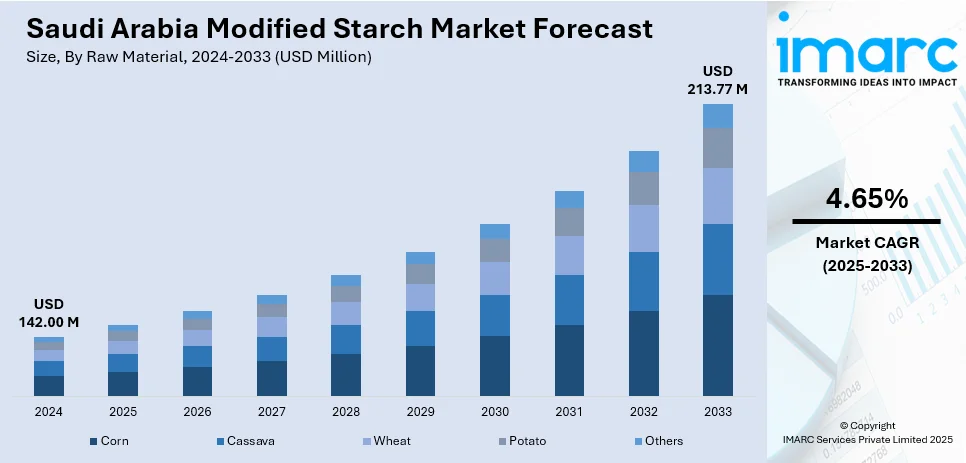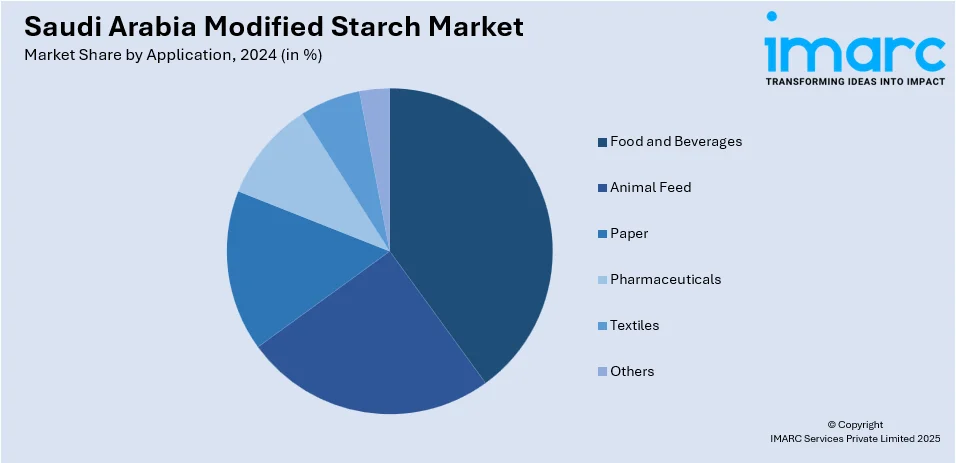
Saudi Arabia Modified Starch Market Size, Share, Trends and Forecast by Raw Material, Type, Function, Application, and Region, 2025-2033
Saudi Arabia Modified Starch Market Overview:
The Saudi Arabia modified starch market size reached USD 142.00 Million in 2024. Looking forward, IMARC Group expects the market to reach USD 213.77 Million by 2033, exhibiting a growth rate (CAGR) of 4.65% during 2025-2033. Rising consumption of processed foods, expansion of convenience food offerings, growth in disposable incomes, government support for local food production, diversification into pharmaceutical and industrial applications, increasing demand for sustainable materials, and advancements in starch modification technologies are some of the factors positively impacting the market.
|
Report Attribute
|
Key Statistics
|
|---|---|
|
Base Year
|
2024
|
|
Forecast Years
|
2025-2033
|
|
Historical Years
|
2019-2024
|
| Market Size in 2024 | USD 142.00 Million |
| Market Forecast in 2033 | USD 213.77 Million |
| Market Growth Rate 2025-2033 | 4.65% |
Saudi Arabia Modified Starch Market Trends:
Increasing Demand for Processed and Convenience Foods
With multinational food brands establishing a stronger presence in the region, the Saudi Arabia modified starch market demand is expected to expand, particularly in applications such as dairy products and confectionery. The market is experiencing significant traction due to the rising consumption of processed and convenience foods. As urbanization accelerates and lifestyles become busier, consumers are increasingly opting for ready-to-eat meals, baked goods, and packaged snacks, all of which rely heavily on modified starch as a stabilizing and thickening agent. A study developed acetylated and dual-modified (acetylated-crosslinked) starches from Saudi-grown wheat, demonstrating superior functional properties, acetylated starch achieved 98.6% solubility (vs. 45.2% native) and dual-modified starch showed 3.5x higher freeze-thaw stability, critical for Saudi food industries requiring heat-resistant ingredients in arid climates. The food and beverage industry’s expansion, coupled with growing disposable incomes, has further amplified the need for functional ingredients that enhance texture and shelf life. Additionally, the government’s focus on economic diversification under Vision 2030 has encouraged local food production, which also indirectly supports the Saudi Arabia modified starch market growth.

Expansion of Industrial Applications Beyond Food Sector
Another critical driver for the Saudi Arabia modified starch market is its widening use in non-food industrial applications. The construction sector also contributes to the Saudi Arabia modified starch market share, as modified starch is increasingly used in adhesives and gypsum boards. Furthermore, the growing emphasis on sustainable and bio-based materials has prompted manufacturers to explore starch derivatives as alternatives to synthetic polymers. The pharmaceutical sector, for instance, utilizes modified starch as a binder and disintegrant in tablet formulations, while the paper industry employs it to improve sheet strength and printability. Government initiatives promoting industrial self-sufficiency and technological advancements in starch modification techniques further reinforce this trend. A study characterized native and modified date palm starch from Saudi-grown cultivars, revealing unique functional properties - including high amylose content (28-34%) and thermal stability (peak gelatinization at 76-82°C) - making it suitable for Saudi food industries seeking alternatives to imported corn/wheat starches. The starch's low syneresis (<15% after freeze-thaw cycles) and high water absorption (3.2 g/g) demonstrate particular value for Saudi dairy and bakery sectors, supporting Vision 2030 goals for localized ingredient production in arid climates. This diversification of applications enhances the Saudi Arabia modified starch market outlook, as industries seek cost-effective and environmentally friendly solutions.
Saudi Arabia Modified Starch Market Segmentation:
IMARC Group provides an analysis of the key trends in each segment of the market, along with forecasts at the country and regional levels for 2025-2033. Our report has categorized the market based on raw material, type, function, and application.
Raw Material Insights:
- Corn
- Cassava
- Wheat
- Potato
- Others
The report has provided a detailed breakup and analysis of the market based on the raw material. This includes corn, cassava, wheat, potato, and others.
Type Insights:
- Starch Esters and Ethers
- Resistant
- Cationic
- Pre-gelatinized
- Others
The report has provided a detailed breakup and analysis of the market based on the type. This includes starch esters and ethers, resistant, cationic, pre-gelatinized, and others.
Function Insights:
- Thickeners
- Stabilizers
- Binders
- Emulsifiers
- Others
The report has provided a detailed breakup and analysis of the market based on the function. This includes thickeners, stabilizers, binders, emulsifiers, and others.
Application Insights:

- Food and Beverages
- Animal Feed
- Paper
- Pharmaceuticals
- Textiles
- Others
The report has provided a detailed breakup and analysis of the market based on the application. This includes food and beverages, animal feed, paper, pharmaceuticals, textiles, and others.
Regional Insights:
- Northern and Central Region
- Western Region
- Eastern Region
- Southern Region
The report has also provided a comprehensive analysis of all the major regional markets, which include Northern and Central Region, Western Region, Eastern Region, and Southern Region.
Competitive Landscape:
The market research report has also provided a comprehensive analysis of the competitive landscape. Competitive analysis such as market structure, key player positioning, top winning strategies, competitive dashboard, and company evaluation quadrant has been covered in the report. Also, detailed profiles of all major companies have been provided.
Saudi Arabia Modified Starch Market Report Coverage:
| Report Features | Details |
|---|---|
| Base Year of the Analysis | 2024 |
| Historical Period | 2019-2024 |
| Forecast Period | 2025-2033 |
| Units | Million USD |
| Scope of the Report |
Exploration of Historical Trends and Market Outlook, Industry Catalysts and Challenges, Segment-Wise Historical and Future Market Assessment:
|
| Raw Materials Covered | Corn, Cassava, Wheat, Potato, Others |
| Types Covered | Starch Esters and Ethers, Resistant, Cationic, Pre-gelatinized, Others |
| Functions Covered | Thickeners, Stabilizers, Binders, Emulsifiers, Others |
| Applications Covered | Food and Beverages, Animal Feed, Paper, Pharmaceuticals, Textiles, Others |
| Regions Covered | Northern and Central Region, Western Region, Eastern Region, Southern Region |
| Customization Scope | 10% Free Customization |
| Post-Sale Analyst Support | 10-12 Weeks |
| Delivery Format | PDF and Excel through Email (We can also provide the editable version of the report in PPT/Word format on special request) |
Key Questions Answered in This Report:
- How has the Saudi Arabia modified starch market performed so far and how will it perform in the coming years?
- What is the breakup of the Saudi Arabia modified starch market on the basis of raw material?
- What is the breakup of the Saudi Arabia modified starch market on the basis of type?
- What is the breakup of the Saudi Arabia modified starch market on the basis of function?
- What is the breakup of the Saudi Arabia modified starch market on the basis of application?
- What is the breakup of the Saudi Arabia modified starch market on the basis of region?
- What are the various stages in the value chain of the Saudi Arabia modified starch market?
- What are the key driving factors and challenges in the Saudi Arabia modified starch market?
- What is the structure of the Saudi Arabia modified starch market and who are the key players?
- What is the degree of competition in the Saudi Arabia modified starch market?
Key Benefits for Stakeholders:
- IMARC’s industry report offers a comprehensive quantitative analysis of various market segments, historical and current market trends, market forecasts, and dynamics of the Saudi Arabia modified starch market from 2019-2033.
- The research report provides the latest information on the market drivers, challenges, and opportunities in the Saudi Arabia modified starch market.
- Porter's five forces analysis assist stakeholders in assessing the impact of new entrants, competitive rivalry, supplier power, buyer power, and the threat of substitution. It helps stakeholders to analyze the level of competition within the Saudi Arabia modified starch industry and its attractiveness.
- Competitive landscape allows stakeholders to understand their competitive environment and provides an insight into the current positions of key players in the market.
Need more help?
- Speak to our experienced analysts for insights on the current market scenarios.
- Include additional segments and countries to customize the report as per your requirement.
- Gain an unparalleled competitive advantage in your domain by understanding how to utilize the report and positively impacting your operations and revenue.
- For further assistance, please connect with our analysts.
 Request Customization
Request Customization
 Speak to an Analyst
Speak to an Analyst
 Request Brochure
Request Brochure
 Inquire Before Buying
Inquire Before Buying




.webp)




.webp)












